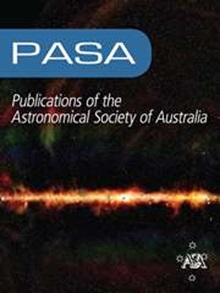Fast as Potoroo: Radio Continuum Detection of a Bow-Shock Pulsar Wind Nebula Powered by Pulsar J1638–4713
IF 4.6
3区 物理与天体物理
Q1 ASTRONOMY & ASTROPHYSICS
Publications of the Astronomical Society of Australia
Pub Date : 2024-03-25
DOI:10.1017/pasa.2024.13
引用次数: 0
Abstract
We report the discovery of a bow-shock pulsar wind nebula (PWN), named Potoroo, and the detection of a young pulsar J1638–4713 that powers the nebula. We present a radio continuum study of the PWN based on 20-cm observations obtained from the Australian Square Kilometre Array Pathfinder (ASKAP) and MeerKAT. PSR J1638–4713 was identified using Parkes radio telescope observations at frequencies above 3 GHz. The pulsar has the second-highest dispersion measure of all known radio pulsars (1553 pc cm像波托鲁一样快脉冲星 J1638-4713 驱动的弓震脉冲星风星云的射电连续探测
我们报告发现了一个名为 "Potoroo "的弓形冲击脉冲星风星云(PWN),并探测到了为该星云提供能量的一颗年轻脉冲星J1638-4713。我们根据从澳大利亚平方公里阵列探路者(ASKAP)和MeerKAT获得的20厘米观测数据,介绍了对PWN的射电连续波研究。PSR J1638-4713 是通过帕克斯射电望远镜在 3 GHz 以上频率的观测发现的。该脉冲星在所有已知射电脉冲星中具有第二高的色散测量值(1553 pc cm-3),自旋周期为 65.74 ms,自旋下降光度为 Ė = 6.1 × 1036 erg s-1。这颗脉冲星具有彗星形态,是所有观测到的脉冲星射电尾迹中投影长度最大的一个,在假定距离为 10 kpc 的情况下,其投影长度超过 21 pc。超长的尾部和异常陡峭的射电光谱指数归因于超新星反向冲击和PWN的相互作用。目前还不知道超新星残余物的起源。我们估计脉冲星的踢速度在 1000-2000 km s-1 之间,年龄在 23-10 kyr 之间。钱德拉数据中发现的 X 射线对应星 CXOU J163802.6-471358,其尾部形态与射电源相同,但比射电源短 10 倍。X 射线发射的峰值与射电总强度(斯托克斯 I)发射的峰值相差约 4.7",但与圆偏振(斯托克斯 V)发射非常吻合。没有发现红外线对应物。
本文章由计算机程序翻译,如有差异,请以英文原文为准。
求助全文
约1分钟内获得全文
求助全文
来源期刊
CiteScore
5.90
自引率
9.50%
发文量
41
审稿时长
>12 weeks
期刊介绍:
Publications of the Astronomical Society of Australia (PASA) publishes new and significant research in astronomy and astrophysics. PASA covers a wide range of topics within astronomy, including multi-wavelength observations, theoretical modelling, computational astronomy and visualisation. PASA also maintains its heritage of publishing results on southern hemisphere astronomy and on astronomy with Australian facilities.
PASA publishes research papers, review papers and special series on topical issues, making use of expert international reviewers and an experienced Editorial Board. As an electronic-only journal, PASA publishes paper by paper, ensuring a rapid publication rate. There are no page charges. PASA''s Editorial Board approve a certain number of papers per year to be published Open Access without a publication fee.

 求助内容:
求助内容: 应助结果提醒方式:
应助结果提醒方式:


